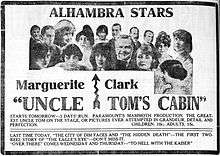Uncle Tom's Cabin (1918 film)
| Uncle Tom's Cabin | |
|---|---|
 Newspaper advertisement | |
| Directed by | J. Searle Dawley |
| Produced by |
Adolph Zukor Jesse L. Lasky |
| Written by | J. Searle Dawley |
| Based on |
Uncle Tom's Cabin by Harriet Beecher Stowe Uncle Tom's Cabin by George Aiken |
| Starring |
Marguerite Clark Frank Losee |
| Cinematography | H. Lyman Broening |
Production company | |
| Distributed by | Paramount Pictures |
Release dates |
|
Running time | 5 reels |
| Country | United States |
| Language | Silent (English intertitles) |
Uncle Tom's Cabin was a 1918 American silent drama film directed by J. Searle Dawley, produced by Famous Players-Lasky Corporation and distributed by Paramount Pictures under the Famous Players-Lasky name. The film is based on Harriet Beecher Stowe's 1852 novel Uncle Tom's Cabin and George Aiken's eponymous play.[1]
Uncle Tom's Cabin starred Marguerite Clark, who portrayed both Topsy and Little Eva.[2] It is now considered to be a lost film.[3]
Plot
As described in a film magazine,[4] Uncle Tom (Losee) is on his way to the slave market. Eva St. Clair (Clark) and her father are returning to their New Orleans home when Uncle Tom rescues Little Eva from drowning. Mr. St. Clair (Stanford) buys him and Uncle Tom becomes the delight of Little Eva. Eva's declining health concerns her parents and she finally dies. Shortly thereafter St. Clair is killed, and the St. Clair slaves, including Uncle Tom, are sold. Topsy (Clark), given to Eva's aunt, is retained and taken north. With one of Eva's blond curls as a talisman, Topsy loses her wild, impish ways and becomes a trusted servant of Aunt Ophelia. (Morrison).
Cast
- Marguerite Clark as Little Eva St. Clair / Topsy
- Sam Hardy as Simon Legree
- Jack W. Johnston as Haley
- Florence Carpenter as Eliza Harris
- Frank Losee as Uncle Tom
- Phil Ryley as Marks
- Harry Lee as Jeff
- Walter P. Lewis as Simon Legree (credited as Walter Lewis)
- Augusta Anderson as Mrs. St. Clair
- Ruby Hoffman as Cassy
- Susanne Willis as Aunt Chloe
- Mrs. Priestly Morrison as Ophelia (credited as Mrs. Priestley Morrison)
- Thomas Carnahan, Jr. as George Shelby Jr.
- Jere Austin as George Harris
- Henry Stanford as Mr. St. Clair
Production notes
Part of the film were shot on location in Louisiana, New York City and Maine.[1] The film's star, Marguerite Clark, portrayed both Little Eva and Topsy in the film. In order to present both characters on the screen on the same time, the filmmakers used the process of double exposure.[5]
Reception
Like many American films of the time, Uncle Tom's Cabin was subject to cuts by city and state film censorship boards. For example, the Chicago Board of Censors required cuts of two offensive intertitles, in Reel 1, "A nigger is only a nigger" and, Reel 2, "Do you allow her to embrace niggers that way?"[6]
See also
References
- 1 2 Gevinson, Alan (1997). Within Our Gates: Ethnicity in American Feature Films, 1911-1960. University of California Press. p. 1079. ISBN 0-520-20964-8.
- ↑ Progressive Silent Film List: Uncle Tom's Cabin at silentera.com
- ↑ Nunn, Curtis (1981). Marguerite Clark, America's Darling of Broadway and the Silent Screen. TCU Press. p. VII.
- ↑ "Reviews: Uncle Tom's Cabin". Exhibitors Herald. New York City: Exhibitors Herald Company. 7 (6): 33. August 3, 1918.
- ↑ Tepa Lupack, Barbara, ed. (1999). Nineteenth-century Women at the Movies: Adapting Classic Women's Fiction to Film. Popular Press. p. 229. ISBN 0-879-72805-1.
- ↑ "Official Cut-Outs by the Chicago Board of Censors". Exhibitors Herald. 7 (9): 36. August 24, 1918.
External links
- Uncle Tom's Cabin at the Internet Movie Database
- Uncle Tom's Cabin at AllMovie
- Lobby card designed for the 1918 film
- Marguerite Clark (in a blond wig as Eva) and Frank Losee (black face as Uncle Tom)
- Marguerite Clark in blackface(archived)